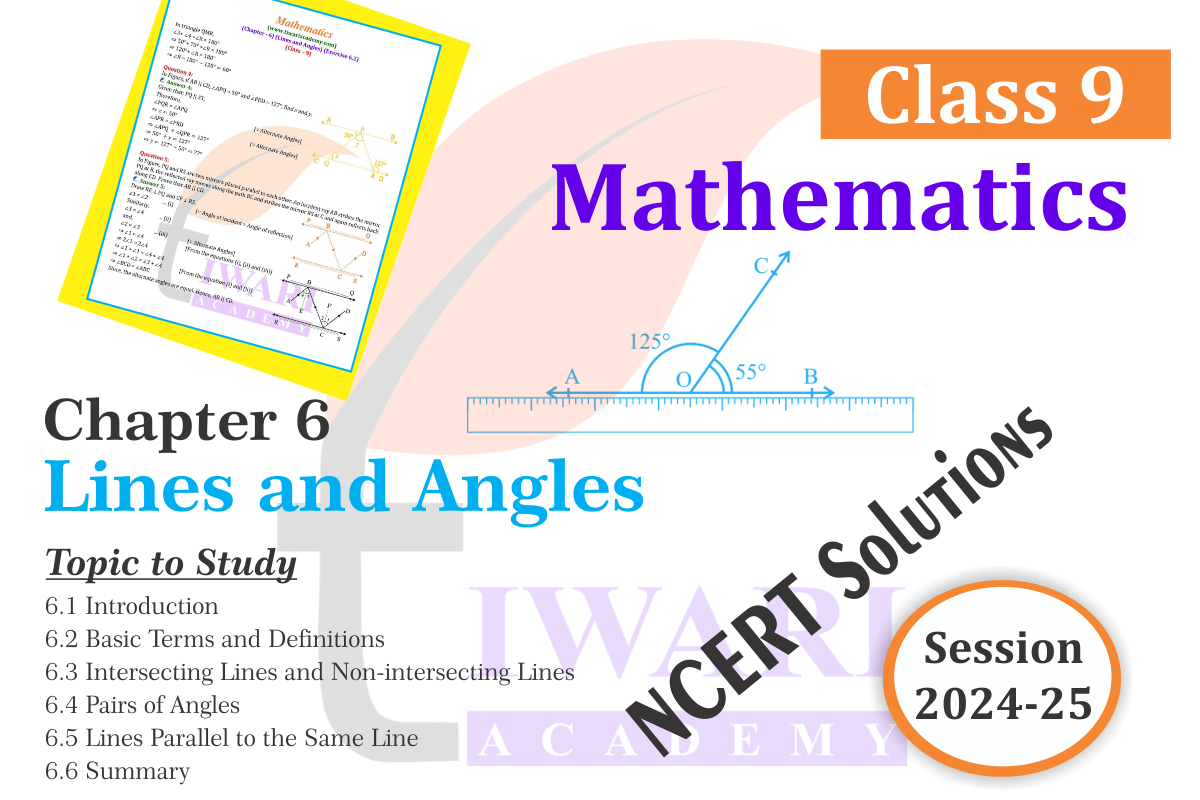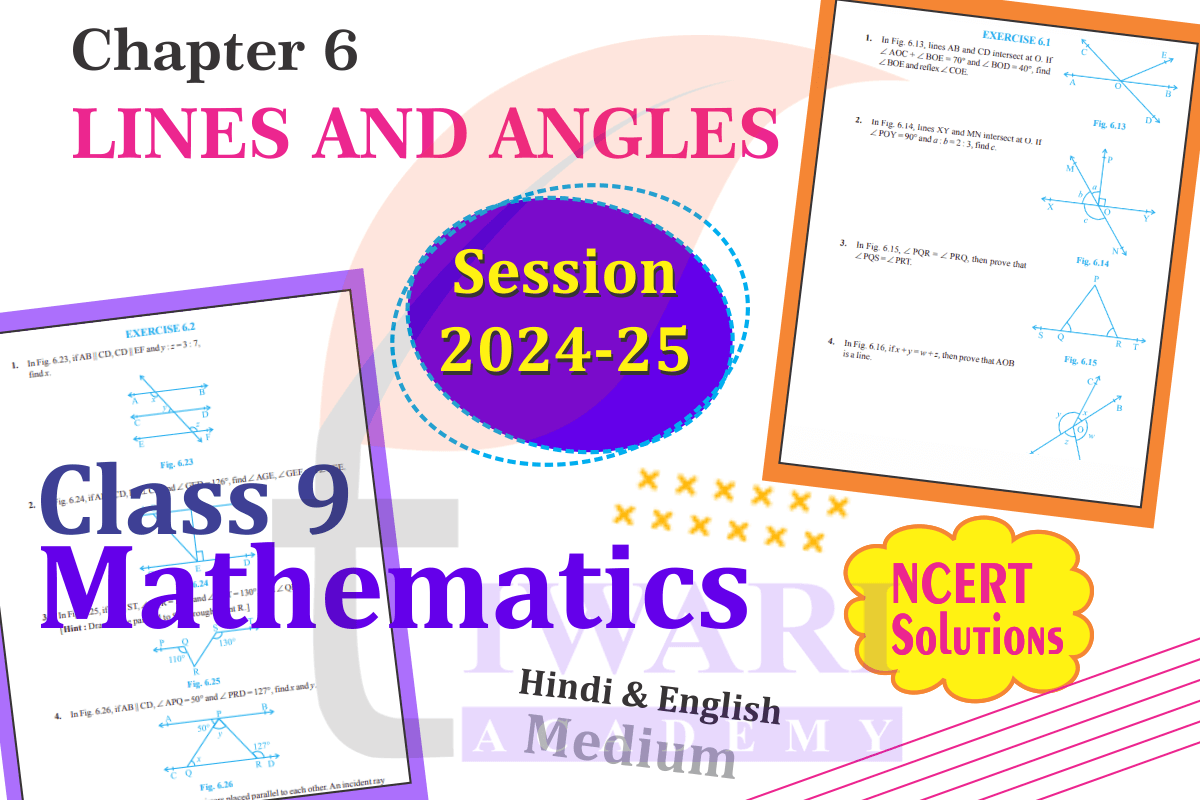NCERT Solutions for Class 9 Maths Chapter 6 Lines and Angles in English and Hindi Medium updated for academic session 2024-25. As per new syllabus there are only two exercises in 9th Maths chapter 6 which is given in new NCERT book for CBSE 2024-25.
Class 9 Maths Chapter 6 Solutions for CBSE Board
Class 9 Maths Exercise 6.1 in English
Class 9 Maths Exercise 6.2 in English
Class 9 Maths Chapter 6 Solutions for State Boards
Class 9 Maths Chapter 6 Exercise 6.1
Class 9 Maths Chapter 6 Exercise 6.2
Class 9 Maths Chapter 6 Exercise 6.3
Tiwari Academy typically provides detailed and comprehensive solutions to the Class 9 Maths NCERT textbook. These solutions break down complex mathematical concepts into simpler, step-by-step explanations, making it easier for students to understand and follow.
Class 9 Maths Chapter 6 Solutions in Hindi Medium
Class 9 Maths Exercise 6.1 in Hindi
Class 9 Maths Exercise 6.2 in Hindi
The solutions offered on Tiwari Academy website and app often focus on building a strong foundation of mathematical concepts. This can help students gain a clear understanding of the subject matter, which is crucial for success in mathematics.
NCERT Solutions for Class 9 Maths Chapter 6
| Class: 9 | Mathematics |
| Chapter 6: | Lines and Angles |
| Number of Exercises: | 2 (Two) |
| Content: | NCERT Exercises Solution |
| Mode of Content: | Images, Text, PDF and Videos |
| Academic Session: | CBSE 2024-25 |
| Medium: | English and Hindi Medium |

UP Board Solutions for Class 9 Maths Chapter 6 Prashnavali 6.1, and Prashnavali 6.2 of Rekhaen aur Kon in Hindi Medium are given below to free download in PDF file format. All the question answers are updated for academic year 2024-25. 9th Maths Solutions for Chapter 6 are compatible for UP Board and CBSE Board Students. The NCERT Solutions 2024-25 can be used in Video format by all the Boards like CBSE Board, MP Board, Gujrat, Board, UP Board and other board following NCERT (https://ncert.nic.in/) Books in the academic session 2024-25 onward. Chapter 6 of 9th Mathematics includes the concepts of Lines and Angles. It is the first chapter in Geometry in class 9 Maths, which takes time to understand the concepts.
Study Material for Class 9 Maths Chapter 6

Class 9 Maths Chapter 6 Practice Questions with Solution
What are Intersecting lines?
Intersecting lines: Two lines are said to be intersecting, if they intersect each other at one point.
What is meant by Parallel lines?
Parallel lines: Lines in the same plane which do not intersect when produced on either side.
What do you know about Transversal lines?
Transversal lines: It is a straight line which cuts two or more straight lines at distinct point.
What is an Acute angle?
Acute angle: An angle whose measure is less than 90 but more than 0.
What do you understand by an Obtuse angle?
Obtuse angle: An angle whose measure is more than 90 but less than 180.
What is a Right angle?
Right angle: An angle whose measure is 90.
What is the measure of a Straight angle?
Straight angle: The measure of a straight angle is 180.
What is Reflex angl?
Reflex angle: An angle whose measure is more than 180 but less than 360.
Which angle is called Complete angle?
Complete angle: An angle whose measure is 360.
What are Complementary angles?
Complementary angles: Two angles are said to be complementary, if the sum of their measure is 90.
What are Supplementary angles?
Supplementary angles: Two angles are said to be supplementary, if the sum of their measure is 180.
What are Adjacent angles?
Adjacent angles: Two angles are called adjacent angles, if they have a common vertex and common arm.
What do you know about Vertically opposite angles?
Vertically opposite angles: Two angles are said to be a pair of vertically opposite angles, if their arms from two pairs of opposite rays.
9th Maths Chapter 6 Solutions in English & Hindi Medium
NCERT Solutions for class 9 Maths Chapter 6 Exercise 6.1, and 6.2 Lines and angles in English Medium as well as Hindi Medium in PDF form as well as study online options are given for academic session 2024-25. UP Board or CBSE Board or other boards students can ask their doubts and reply to other users through Tiwari Academy Discussion Forum. A platform to share your knowledge.
Important Questions on 9th Maths Chapter 6
What are the different types of angle?
An acute angle measures between 0° and 90°, whereas a right angle is exactly equal to 90°. An angle greater than 90° but less than 180° is called an obtuse angle. A straight angle is equal to 180°. An angle which is greater than 180° but less than 360° is called a reflex angle. Further, two angles whose sum is 90° are called complementary angles, and two angles whose sum is 180° are called supplementary angles.
What is a line-segment?
A part (or portion) of a line with two end points is called a line-segment.
What is a ray?
A part of a line with one end point is called a ray.
What do you mean by collinear points or non-collinear points?
If three or more points lie on the same line, they are called collinear points; otherwise they are called non-collinear points.
What happens If a transversal intersects two parallel lines?
(i) each pair of corresponding angles is equal, (ii) each pair of alternate interior angles is equal, (iii) each pair of interior angles on the same side of the transversal is supplementary.
What is the sum of the three angles of a triangle?
The sum of the three angles of a triangle is 180°.
Important Notes on 9th Maths Chapter 6
If a transversal intersects two parallel lines, then
1. Each of the alternate interior angles is equal. (Converse is also true).
2. Each pair of interior angles on the same side of the transversal is supplementary. (Converse is also true).
3. Each pair of corresponding angles is equal.
What are the uses of Lines and Angles chapter 6 of class 9th Maths in daily life?
Lines and angles are extremely important in many aspects of real life given below:
- Architect/Engineers use angle measurements to construct buildings, bridges, houses, monuments, etc.
- Carpenters use angle measuring devices such as protractors to make furniture like chairs, tables, beds, wooden, etc.
- We can see the angle in the clocks of our homes, made by hands of clocks. For example, if the small hand is in 3 and the big hand is in 12, we get a right angle.
- Athletes use angles to enhance their performance.
- Artists use their knowledge of angles to sketch portraits and paintings.
- Real-world examples of line/line segments are a pencil, a baseball bat, the cord to your cell phone charger, the edge of a table, etc.
- The line is an element of design and an essential part of many forms of art.
- Whenever an architect has to draw a plan for a multistoried building, she has to draw intersecting lines and parallel lines at different angles.
- To find the height of a tower or to find the distance of a ship from the light house, one needs to know the angle formed between the horizontal and the line of sight.
Which topic’s knowledge will students gain after completing chapter 6 of class 9th Maths?
After completing chapter 6 of class 9th Maths, students will gain the knowledge of the following topics:
- Basic terms and definitions (Line-segment, Ray, Collinear points, Non-collinear points, Angles, Arms, Vertex).
- Types of Angles (Acute angle, Obtuse angle, Straight angle, Right angle, Reflex angle).
- Meaning of Complementary, Supplementary Angles, Linear pair of angles, Vertically opposite angles.
- Intersecting Lines and Non-intersecting Lines.
- Parallel Lines and a Transversal.
- Lines which are parallel to the same line are parallel to each other.
- Angle sum property of a triangle.
How many exercises, questions, and examples are there in chapter 6 (Lines and Angles) of class 9th mathematics?
There are three exercises in class 9 mathematics chapter 6 (Lines and Angles).
In the first exercise (Ex 6.1), there are six questions.
In the second exercise (Ex 6.2), there are six questions.
So, there are 12 questions in class 9 mathematics chapter 6 (Lines and Angles).
In this chapter, there are six examples also. Examples 1, 2, 3 are based on Ex 6.1, and examples 4, 5, 6 are based on Ex 6.2.
Which theorem can be asked in the school exam for proof from chapter 6 of class 9th Maths?
There are eight theorems in Chapter 6 Lines and Angles of class 9th Maths. All the theorems are important. The theorems whose proof can come in the school exam are:
- 1) Theorem 6.1 (If two lines intersect each other, then the vertically opposite angles are equal)
- 2) Theorem 6.6 (Lines which are parallel to the same line are parallel to each other)
- 3) Theorem 6.7 (Angle Sum Property of a Triangle).


